Apple's 2010 MacBook Air (11 & 13 inch) Thoroughly Reviewed
by Anand Lal Shimpi on October 26, 2010 10:08 PM EST- Posted in
- Mac
- Apple
- MacBook Air
- Laptops
The 11-inch MacBook Air: Faster than the old 13-inch MacBook Air
On paper, the new 13-inch MacBook Air shouldn’t be any faster than the old 2008 MacBook Air - at least in CPU bound tasks. The 2010 model gets a faster GPU but the CPU is literally the same 1.86GHz Core 2 Duo. Memory sizes and speeds haven’t changed either. While the SSD is faster, if you’re running a CPU bound benchmark there shouldn’t be any performance difference. If you assumed the same thing I did, you’d be very wrong.
Take a look at Cinebench 11 comparing the 2008 13-inch MacBook Air to the two 2010 models:
| Cinebench 11 - Multithreaded CPU Benchmark | |||||
| 11-inch MacBook Air (2010) - 1.4GHz Core 2 Duo | 13-inch MacBook Air (2010) - 1.86GHz Core 2 Duo | 13-inch MacBook Air (2008) - 1.86GHz Core 2 Duo | |||
| Cinebench 11 Score (Higher is Better) | 0.81 | 1.1 | 0.70 | ||
Not only is the 2008 13-inch MBA slower than the new 13-inch model, it’s actually slower than the 11-inch model running at 1.4GHz. Something is amiss. Perhaps it’s just this benchmark?
I turned to our Handbrake H.264 encode test to verify my sanity:
| Handbrake 0.94 - H.264 High Profile Transcode | |||||
| 11-inch MacBook Air (2010) - 1.4GHz Core 2 Duo | 13-inch MacBook Air (2010) - 1.86GHz Core 2 Duo | 13-inch MacBook Air (2008) - 1.86GHz Core 2 Duo | |||
| Average Frames per Second (Higher is Better) | 1.14 fps | 1.55 fps | 0.96 fps | ||
Once again, a similar situation. The old MBA is actually slower than the new 11-inch, despite the advantage in CPU speed.
It looks like what we’ve stumbled upon is a combination of Apple aggressively throttling the clock speed of the older MacBook Air CPUs to meet thermal requirements, and the CPUs used in the new MacBook Airs being far better behaved from a voltage/power consumption standpoint.
The 45nm process these Core 2s are built on is as mature as it’s going to get. I’m guessing yield on these parts is as high as can be and as a result, power consumption is probably consistently lower than the original 1.86GHz parts Apple shipped back in 2008. The peak thermal specs themselves haven’t changed, but the actual power characteristics have.
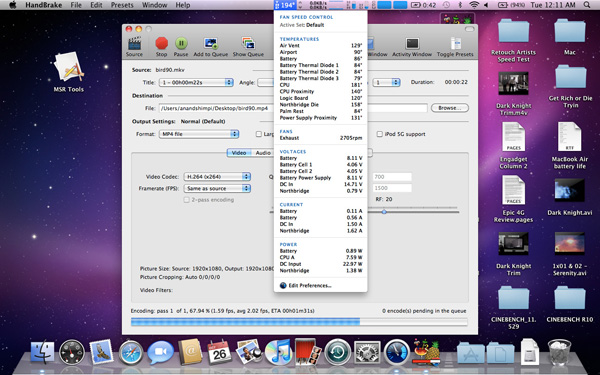
The 2008 MacBook Air under Load
Maximum temperature, at least reported by the MBA’s sensors, isn’t any lower on the new 13-inch than the 2008 I compared it to. Both CPUs hit roughly 84C (183F) under full load. But look at what happens to the chips after a minute at that load:
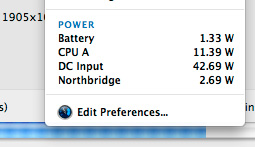 2010 13-inch MacBook Air |
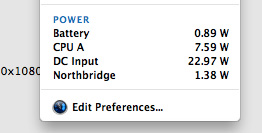 2008 13-inch MacBook Air |
iStat Menus reports the 1.86GHz Core 2 Duo in the 2008 system consuming only 7.59W, while the same CPU in the 2010 machine is drawing 11.45W. The 2008 machine is throttling back to reduce overall temperature while the 2010 system keeps going.
As a result, even the 11-inch MacBook Air will probably end up being as fast, if not faster than the 2nd generation 2008 13-inch MacBook Air. And our performance results confirm that:
| 11-inch MacBook Air (2010) vs. 13-inch MacBook Air (2008) | ||||||||
| Application Launch Test | Adobe Photoshop CS4 | Aperture RAW Import | Cinebench R10 - 1CPU | Cinebench R10 - XCPU | Quicktime H.264 Transcode | |||
| Apple 11-inch MacBook Air (2010) - 1.4GHz Core 2 Duo | 27.8 seconds | 72.4 seconds | 1.29 PPS | 1612 | 2967 | 33.1 fps | ||
| Apple 13-inch MacBook Air (2008) - 1.86GHz Core 2 Duo | 26.4 seconds | 71.3 seconds | 1.20 PPS | 2046 | 2882 | 30.1 fps | ||
You'll notice the less CPU intensive tasks are quicker on the old 13-inch system as the CPU isn't able to get hot enough to trigger Apple's throttling. The single threaded Cinebench test is the best example of this. The 26% performance advantage jibes with the 33% increase in CPU clock speed (it's actually a little low, most likely because the old CPU still isn't running at full speed even in this test). But now look at the heavier tests - the multithreaded Cinebench test and the Quicktime encode. Both of these stress both cores and drive TDP up, which forces Apple to pull clock speed back down. We wondered how Apple was able to cram such a high speed CPU into such a thin chassis as early as it did, now we know.
In practice I found the 2008 13-inch MBA launched applications quicker (short bursts of full clock speed), but after prolonged use or completing CPU intensive tasks it was tough to tell apart from the new 11-inch. What's even more troublesome is that Apple's aggressive clock throttling went relatively undetected until now. This is something I'm going to have to devise tests for and pay more attention to in future reviews. Sneaky, Steve, sneaky.
External Temperatures and Noise
The old MacBook Air chassis had a few dozen slits cut out of the aluminum for ventilation. The new MacBook Air chassis hides the ventilation slits between the base of the unit and the hinge. You can’t see them, but they’re there.
The slits are smaller than they were on the old chassis, which means moving air through them at the same rate sounds louder than before.
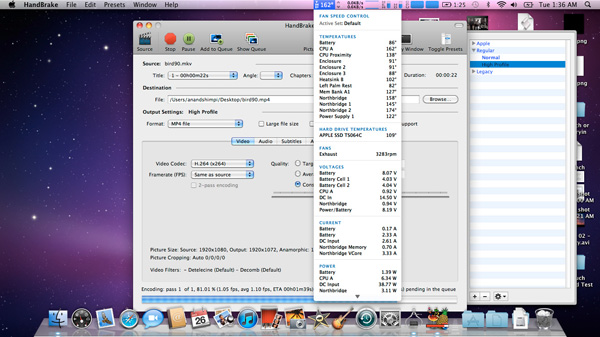
The 11-inch MacBook Air under Load
The CPU in the 11-inch model, even when under heavy loads, likes to stay at or below 72C (162F). At that temperature, the internal fan doesn’t spin above 4000 RPM (usually down below 3400). The 13-inch MacBook Air however is far more likely to generate noise. Running our simple Handbrake test the CPU will peak at over 82C (~180F) and the system’s internal fan will ramp up to over 6K RPM to compensate. Not only does the chassis get hot, but the fan gets audible. It’s still too small of a fan to really be considered loud in the grand scheme of things, but it’s loud enough to be annoying.
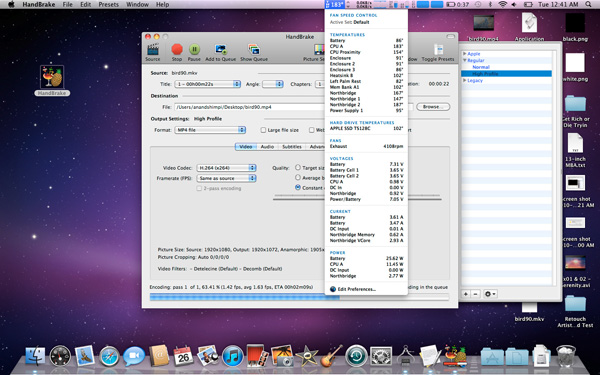
The 13-inch Macbook Air under Load
The surface temperature of the new 13-inch MacBook Air easily gets as high as the 2008 model. I measured a peak of 38.9C (102F) on both the 2008 and 2010 13-inch models. The 11-inch never broke 38C (100F).
Even casual use can ramp up temperatures pretty quickly. Just having a few websites open in the background that use Flash or other CPU intensive elements can slowly cause the MBA’s internal temperatures to rise. And now you’re beginning to see why Apple doesn’t install Flash on these things by default.
The danger zone is the upper left corner of the system, near the hinge. There’s only a single fan that cools both the CPU and GPU in the Air’s very tight enclosure. This is where that fan sits.










185 Comments
View All Comments
hmurchison - Tuesday, October 26, 2010 - link
Other than build your own computer (which is overrated IMO) there's little you can do with your PC that I can't do with my Mac.Yup ...I have style which means that I do get "owned" by the finer things in life. I don't have a tacky 3rd rate Alienware like box sitting on my desk. I could easily program by installing the free Xcode IDE that comes on my disk and create apps if I so choose. With Unix underpinnings I can do terminal commands and geek out if I want to.
I'm not a lowest bidder guy nor to I spend an inordinate amount of time tinkering. My time is precious and time is the one thing money ..or cheap PC cannot deliver.
StevoLincolnite - Tuesday, October 26, 2010 - link
See... Everyone is different, everyone has different tastes.To me Apples products don't look all that attractive to myself, from a hardware or an aesthetics perspective.
I like my big flashy case full of UV Cathodes and LEDs which highlight my impressive looking water cooling loops running from my crossfire setup and Core i7 which can be admired through the side window.
Nothing Apple has ever made has actually "Impressed" me from any angle, not the Aesthetics, the hardware, none of it, hence they aren't for me and a reason why I have never owned an Apple product.
My neighbor even modded his Laptop so that it was all made from a clear plastic, and that to has a bunch of nice looking LED's inside of it which lights up really well and does look impressive.
These... I dunno, the look just doesn't do it for me.
As for the touchpad... I use a keyboard to scroll down a webpage, I guess it's a habit from the days of Ball-Mice giving me hell, so I used a keyboard as much as possible.
martyrant - Wednesday, October 27, 2010 - link
Please, just because Apple tells you you have style doesn't mean you do.Again, you got owned by advertising, and you probably look like a giant douche or a turd sandwich when you walk around, all the while thinking in your head you are the sh*t!
synaesthetic - Wednesday, October 27, 2010 - link
play games? *cough*no, bootcamping Windows does not count.
captainBOB - Wednesday, October 27, 2010 - link
Its called Steam for the MacIts also called TF2, HL2, HL2: Ep 1 and 2, Portal, Left for Dead 2, HL2: Deathmatch, Starcraft 2, Diablo 3 (when it arrives) WoW, City of Heroes: Going Rouge, Day of Defeat, CS: Source, EVE Online, Civilization IV.... they don't look like indie games.... should I keep going?
Sure its not quite the library that Windows based PCs have, but the argument that Macs can't play games was dead in the water when Valve brought Steam to the Mac.
Oh and no, It can't play Crysis.
MikosNZ - Wednesday, October 27, 2010 - link
Most of those games are old and you will note they are only AAA titles. Yes you are right a handful of the most popular games come to OSX. But the vast majority do not.Apple and Apple OSX are a nice platform but they most certainly are not a serious gaming platform. Fine for the hobbyist gamer not anyone who spends a significant time gaming.
captainBOB - Wednesday, October 27, 2010 - link
Yep, I mention the big AAA games because they aren't so quickly dismissed as say, "Torchlight" or the other nice indie games on Steam available for both platforms.Definitely a Mac a gaming machine does not make. Just wanted to clear up a misconception that Macs cannot play games. Better to jump into the Hundred Years flame war prepared.
solgae1784 - Tuesday, October 26, 2010 - link
Display is still one of Apple notebook/laptop strengths.....11 inch Air has the same res (1366x768) as most manufacturers use in 15 inch display and some of the 13 inch displays. 13 inch Air has the same res as the Macbook Pro 15 inch model (1400x900), which also puts most other manufacturer's 15 inch display notebooks/laptops to shame with its paltry 1366x768 res. When will those other manufacturers learn that 768p (or heaven forbid, 800p) on a 15 inch screen is just not large enough?I have also yet to saw a single touchpad that can at least match Apple notebook/laptop's implementation. Scrolling is just plain frustrating (especially horizontal scrolling) on those touchpads.
Accord99 - Wednesday, October 27, 2010 - link
"When will those other manufacturers learn that 768p (or heaven forbid, 800p) on a 15 inch screen is just not large enough?"It's a good thing other manufacturers offer products that use higher resolutions like 1920x1080 or 1920x1200, something not available on a Mac except at 17".
solgae1784 - Wednesday, October 27, 2010 - link
I checked just now on Dell/HP/ASUS/Lenovo 15" notebook and apart from Alienware notebooks, none of them offered anything but a 768p res. Dell used to offer a 900p res on their XPS 15" line, but that option is gone as of now. I don't recall any notebook/laptops apart from Alienware that offered a 1080p or 1200p res on a 15" screen notebook.